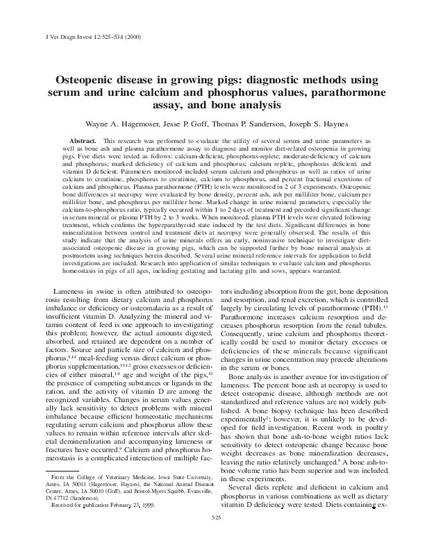
Article
Osteopenic Disease in Growing Pigs: Diagnostic Methods Using Serum and Urine Calcium and Phosphorus Values, Parathormone Assay, and Bone Analysis
Journal of Veterinary Diagnostic Investigation
Document Type
Article
Disciplines
Publication Version
Published Version
Publication Date
11-1-2000
DOI
10.1177/104063870001200606
Abstract
This research was performed to evaluate the utility of several serum and urine parameters as well as bone ash and plasma parathormone assay to diagnose and monitor diet-related osteopenia in growing pigs. Five diets were tested as follows: calcium-deficient, phosphorus-replete; moderate-deficiency of calcium and phosphorus; marked deficiency of calcium and phosphorus; calcium replete, phosphorus deficient; and vitamin D deficient. Parameters monitored included serum calcium and phosphorus as well as ratios of urine calcium to creatinine, phosphorus to creatinine, calcium to phosphorus, and percent fractional excretions of calcium and phosphorus. Plasma parathormone (PTH) levels were monitored in 2 of 3 experiments. Osteopenic bone differences at necropsy were evaluated by bone density, percent ash, ash per milliliter bone, calcium per milliliter bone, and phosphorus per milliliter bone. Marked change in urine mineral parameters, especially the calcium-to-phosphorus ratio, typically occurred within 1 to 2 days of treatment and preceded significant change in serum mineral or plasma PTH by 2 to 3 weeks. When monitored, plasma PTH levels were elevated following treatment, which confirms the hyperparathyroid state induced by the test diets. Significant differences in bone mineralization between control and treatment diets at necropsy were generally observed. The results of this study indicate that the analysis of urine minerals offers an early, noninvasive technique to investigate diet-associated osteopenic disease in growing pigs, which can be supported further by bone mineral analysis at postmortem using techniques herein described. Several urine mineral reference intervals for application to field investigations are included. Research into application of similar techniques to evaluate calcium and phosphorus homeostasis in pigs of all ages, including gestating and lactating gilts and sows, appears warranted.
Rights
Works published by employees of the U.S. Government as part of their official duties are not copyrighted within the U.S. The content of this document is not copyrighted.
Language
en
File Format
application/pdf
Citation Information
Wayne A. Hagemoser, Jesse P. Goff, Thomas P. Sanderson and Joseph S. Haynes. "Osteopenic Disease in Growing Pigs: Diagnostic Methods Using Serum and Urine Calcium and Phosphorus Values, Parathormone Assay, and Bone Analysis" Journal of Veterinary Diagnostic Investigation Vol. 12 Iss. 6 (2000) p. 525 - 534 Available at: http://works.bepress.com/joseph-haynes/6/

This article is published as Hagemoser, Wayne A., Jesse P. Goff, Thomas P. Sanderson, and Joseph S. Haynes. "Osteopenic disease in growing pigs: diagnostic methods using serum and urine calcium and phosphorus values, parathormone assay, and bone analysis." Journal of veterinary diagnostic investigation 12, no. 6 (2000): 525-534. doi: 10.1177/104063870001200606. Posted with permission.